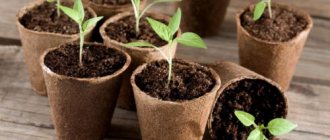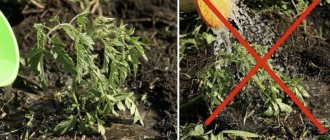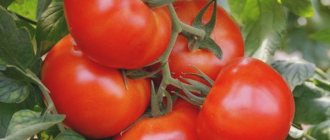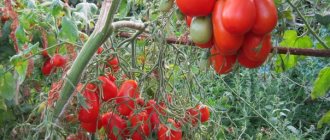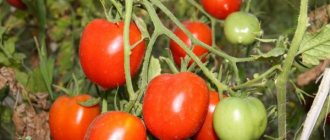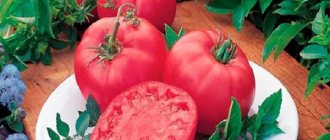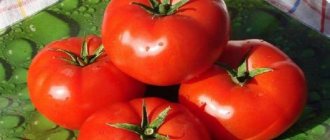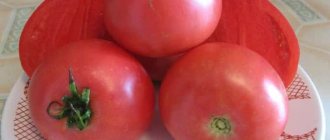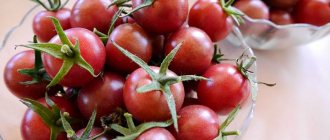Vegetable growers call the Buyan tomato a universal variety. Its unique characteristics make this possible. It fully meets the basic requirements of farmers, has a lot of advantages, and is unpretentious to growing conditions. Siberian scientists developed the Buyan tomato variety in 2012, so it is also well suited for cool climates. In addition to the name Buyan, tomatoes have another name - Fighter. This is the same variety, although there are still two varieties of Buyan - red and yellow. Their properties are the same, only the color and shape of the fruits are different. Red Buyan shows excellent results in the North Caucasus, Middle Volga region, and Kazakhstan. The yellow variety grows better in the West Siberian region.
The variety is considered very productive and unpretentious, therefore it is popular among vegetable growers.
Description of the variety
The Buyan variety is the result of the work of Siberian breeders: in 2012 it was bred specifically for cultivation in conditions of short and cool summers. It can be cultivated both in greenhouses and in open ground. The tomato is easy to care for, bears fruit well, and is ideal for homemade preparations.
Other name and varieties
It is not for nothing that people nicknamed it Fighter - this variety is not susceptible to climate change: it safely survives the cold and does not suffer from drought. Viruses and fungal infections are also not scary for him - the Fighter has excellent immunity to various kinds of microorganisms.
The fruits of this variety can be red or yellow. At the same time, the yellow variety of Buyan is no different in taste from the red one: the differences are only in color and in a more elongated shape, as can be seen in the photo.
Distinctive features
The Buyan tomato is a pure-varietal plant, bred not by crossing several varieties with each other, but by selecting the best plants. Its seeds retain all parental characteristics, which means that all characteristics of the plant are inherited.
This tomato belongs to a low-growing type of plant (determinant variety), that is, when it reaches a certain size, it stops growing, which is very convenient for gardeners: there is no need to tie up bushes or remove excess leaves. Thanks to this, Buyan is also good to grow in a greenhouse.
The plant tolerates temperature changes between day and night, short rainy summers, and high humidity. The period from sprouts to fruiting is one hundred days. Differs in early ripening.
Fruit characteristics, yield
The fruits of Buyan have a rounded, elongated plum-shaped shape. A ripe fruit can weigh on average from 80 to 150 g, has fleshy pulp and thick smooth skin, and a sweet and sour taste. There are few seeds in the pulp: one fruit has 3-6 seed chambers.
Pest and disease control
If the requirements of agricultural technology are met exactly, then the Buyan variety does not suffer from the invasion of parasites or diseases. However, you need to help the plants, so you should not refuse preventive treatments. It is important to know the peculiarity of red Buyan tomatoes. Green spots may appear on the fruit. This is not a disease; after the tomatoes are fully ripened, the spots disappear. The second feature is that tomatoes are prone to cracking when there is excess moisture or nutrition and lack of light.
Preventive treatments with Bordeaux mixture are needed against late blight, calcium nitrate against blossom end rot of fruits.
Among the pests, the Colorado potato beetle, aphids, spider mites or mole crickets are annoying. The methods of fighting are traditional.
How to grow seedlings
With the right approach, Buyan bears fruit regularly throughout its seasonal life. But in order to reap a bountiful harvest, you should take care of the seedlings in advance. Seeds can be bought in the store, but it is better to collect them yourself by the beginning of autumn from the largest fruits.
Seed preparation
To obtain seedlings, smooth, even seeds without defects are used.
Regardless of whether your seeds are purchased or collected yourself, before planting it is recommended to provide them with protection from viruses and infections - pickle them in a solution of potassium permanganate. The main thing here is not to overcook the seeds: 15 minutes is enough.
After potassium permanganate, the seeds should be washed with running water. Immediately before planting, they need to be kept in salt water - this increases the viability of future plants. Seeds from well-known manufacturers do not need to be subjected to such treatment - they are completely ready for sowing.
Container and soil
For planting, you can use whatever is at hand: ceramic pots, wooden or plastic boxes, cups, etc. However, it must be taken into account that the height of the sides should not exceed 10 cm. It is also worth taking care of drainage.
If the soil for seedlings is taken from the garden bed, then it needs to be disinfected, since the likelihood that it contains fungal infections and pest larvae is very high. You can disinfect the soil by holding it in a well-heated oven or pouring boiling water over it. You can etch with the same solution of potassium permanganate.
For your information. For reliable disinfection, soil treatment methods can be combined with each other.
For greater safety, it is better to buy already treated soil in gardening stores.
Sowing
By the end of March, you can start planting, sowing the seeds into the soil at a distance of 2 cm from each other and no deeper than 1 cm. A stable temperature of + 20-25 degrees should be maintained in the room with the seedlings. But the soil cannot be overheated; the seeds may die.
If it is not possible to provide constant heat, you can cover containers with seedlings with film to create a certain microclimate. If sowing is organized correctly, the first shoots will appear in 6-7 days.
Growing and care
In order for the seedlings to grow faster, it is necessary to create conditions for additional lighting.
After seedlings have appeared in the form of two or three leaves, it is necessary to transplant the seedlings into larger containers.
It is useful to feed the sprouts with an ash solution: 1 tablespoon of wood ash per 1 liter of cold water. There is no need to get carried away with fertilizing: 2-3 times before picking plants is enough.
Before planting in the garden, seedlings can be gradually accustomed to the outside temperature: 12 days before transplanting, you need to gradually reduce the temperature in the room and ventilate it frequently. If possible, take pots of seedlings outside for a while.
Young tomatoes are planted in the ground as the soil warms up: the optimal temperature is 15 degrees Celsius. 10-15 days after transplantation, during the formation of the ovary, the plants can be given phosphorus-nitrogen fertilizing. When Buyan is flowering, feed it with mineral and organic fertilizers; it is recommended to include potassium sulfate. After this, add fertilizer two more times - during active plant growth and fruiting.
Since Buyan is a low-growing shrub, it is important to correctly form the bush at the growth stage - 3-4 stems. A plant formed into one stem will bear little fruit.
Watering tomatoes can be done in the usual way or by drip, but always at the root. Do not forget about weeding and removing rotten and dead leaves and stems, as this is a fertile environment for the development of diseases and pests.
Care
The Fighter Brawler tomato, a photo of which is given in the article, is considered a relatively unpretentious variety.
And according to the description, caring for it consists of the usual agrotechnical measures:
- moderate watering;
- periodic feeding;
- weeding and loosening.
But you need to start looking after the plants no earlier than 7-10 days after planting them in the garden. At this time, the tomatoes will adapt to the new environment, and any manipulation will become additional stress for them.
Spraying and watering
Tomatoes Fighter Buyan (description of the variety, photos indicate the average size of the fruit) need regular but moderate watering, without stagnation of moisture at the roots. Depending on the weather, you will need to irrigate the garden bed once every 5-7 days. And under each bush you need to pour 1-2 liters of water. During fruit filling and ripening, the amount of moisture should be increased to 2-4 liters.
Before watering, the water must be slightly warmed. To do this, simply pour it into a container and leave it in the sun for several hours. It is necessary to pour water directly under the root, being careful not to get on the foliage and stems to prevent them from rotting.
It is better to water in cloudy weather, early in the morning or late in the evening. Otherwise, the water will heat up due to the sun's rays and cause burns to the roots of the tomatoes.
Loosening and weeding
After watering or rain, the soil in the garden bed needs to be loosened. Otherwise, it will become denser, and the tomato roots will receive less oxygen, which will negatively affect their yield. To prevent this, it is important to shallowly loosen the soil under the bushes and between the rows. During the procedure, you also need to weed out weeds, because they carry diseases and pests.
To make it easier to care for the planting, the surface of the bed should be mulched with a layer of straw or compost. Organic matter will prevent the rapid evaporation of moisture, prevent the soil from compacting and weeds from breaking through. And then the bed will need to be watered, weeded and loosened less often.
As the mulch decomposes, it will add useful elements to the soil that tomatoes need. But you need to add new portions of organic matter, because over time it is washed out with rain and watering.
Top dressing
Tomatoes of the Buyan Fighter variety should be fed at least 3 times per season.
And it’s better to do it according to the following scheme:
- 3-4 weeks after planting in a greenhouse or open ground, feed with nitrogen compounds. A solution of bird droppings or mullein is suitable. It is better to use superphosphate as a mineral fertilizer.
- During fruit formation, you will need to use phosphorus-potassium complexes. It is better to use monopotassium phosphate or nitrophoska.
- During the ripening period of tomatoes, it is necessary to use potassium-phosphorus fertilizers. The same monopotassium phosphate and nitrophoska will do.
It is better to apply fertilizers in liquid form and only after abundant watering. It is advisable to carry out the procedure itself early in the morning or before sunset. Otherwise, under the influence of sunlight, the compositions will become too aggressive and can burn the plants.
Trimming
Tomatoes Fighter Buyan (variety description, photos are presented in the material) do not need pruning as such. But it is better to tear off the lower leaves on the bushes to improve air access to the roots and prevent plant thickening.
Tying up
Fighter Buyan tomato bushes are compact in size and can be grown without a garter. But it is better to fix the plant shoots to the supports, otherwise they may break off under the weight of the crop. This technique also makes it easier to care for crops and improves the aeration of the planting itself.
You can tie tomatoes either to small supports or to a trellis. In the process you need to use garden twine or pieces of fabric. You cannot use fishing line or wire to tie tomatoes, as they damage the stems, which leads to their rotting.
Optimal conditions
Tomatoes actively develop at temperatures from +10 °C, but for fruit formation they need a temperature within +20...+28 °C. In summer, plants tolerate even more intense heat.
Tomatoes cannot be called frost-resistant, and they die at sub-zero temperatures. True, Buyan Fighter tomatoes can withstand short-term cooling down to 0…+3 °C. But after this, the plants take a long time to recover, which leads to later ripening of the crop.
Tomatoes need good lighting. They do not tolerate drafts and sharp gusts of wind. They are contraindicated in high humidity, which leads to rotting of fruits and roots, and the occurrence of fungal diseases.
Possible difficulties when growing the Buyan variety
For beginning gardeners, not everything always goes smoothly - both in germinating seeds and in further caring for plants.
Problems with seedlings
All conditions have been created, artificial lighting has been established, the seeds are carefully covered with film, but there are no sprouts. What is the reason? In addition to low-quality seeds, the following reasons can lead to this result:
- You may have planted the seeds too deeply in soil that is too heavy for them. The seeds simply suffocated under a layer of airtight soil;
- drainage is not thought out: the soil is peroxidized and fermented, which causes the seed to rot;
- you placed the box with seeds in a very hot room - perhaps next to heating appliances. The seeds could have become soggy from the oversaturation of steam.
Problem with sprouts
Your seeds have sprouted, but they do not bring joy: they are too faded and elongated, as if rickety. This may be for the following reasons:
- lack of light - you should take care of artificial lighting directly above the box with seedlings;
- When planting the seeds, you placed them too close to each other. Transplanting some of the sprouts into another container will help here. But such forced picking slows down the growth of the plant by 12-15 days, this must be taken into account before planting in open ground;
- Perhaps you overdid it with fertilizers, in which case it is better to transplant the seedlings into another, more “calm” soil.
Diseases
Buyan is resistant to most diseases, but if a greenhouse or garden is infected through the soil or garden pests (for example, aphids), then it may also be at risk.
Fungal diseases:
- Gray rot is a disease that affects closely planted plants. Characteristic signs of the disease are a white fluff-like coating on the fruits, spots on the leaves and stems. The drugs “Fundazol” or “Switch” will help fight the disease.
- Fomoz (brown rot) - the entire above-ground part of tomatoes is affected. The disease can be detected by the appearance of the leaves: they are covered with brown spots, which increase with the progress of the disease. If phomosis affects the fruits, then small black spots are visible on them, which also grow. In this case, the core of the fruit is also affected. In the initial stage of the disease, preparations based on copper oxychloride and Bordeaux mixture will help.
- Blackleg - a fungus that attacks the root system of a plant. Conditions for its reproduction can be the constant use of the same land, temperature changes, and high humidity. The fight against the disease will consist of treating the contaminated soil: watering with a solution of potassium permanganate, loosening, and, if necessary, replacing the soil.
Bacterial diseases:
- Bacterial cancer - bacteria infect the vessels of the plant, it begins to wither before our eyes. The disease progresses from the bottom up: from the lower leaves, which curl and wither, to the fruits, where black spots appear on them.
- Necrosis of the stem core - manifests itself during fruiting. Light spots appear on the leaves, and the leaves themselves curl. As a result of the disease, the tomato stem becomes hollow and brittle from the inside, and the plant dies.
- Bacterial fruit spotting affects early-ripening varieties planted in early spring. All parts of the plant suffer, the disease manifests itself in the form of growing spots on the leaves and stems. When blooming, the flowers are affected - they dry out.
In case of bacterial diseases, it is necessary to carry out protective measures in the form of weeding and removal of affected parts of the plant. If signs of disease are detected, plants must be sprayed with Abiga-Pik solution. The preparations “Fitolavin-300”, “Gamair” and “Baktofit” are recommended as the most effective in the fight against bacterial diseases.
For your information. Greenish spots may appear on the fruits of the Buyan variety. This is not a disease, but a feature of the variety. As the fruit ripens, the spots disappear.
Pests
Buyan tomatoes grown in greenhouses are most often attacked by spider mites. The tick feeds on the sap of the plant, biting through its leaves, which as a result begin to turn yellow, become covered with small dots and dry out.
If the mite is found in abundance on plants, a cobweb will be visible - a waste product of the pest. If you see cobwebs on your tomatoes, it’s time to act, because this is a sign that the plants are at high risk and may die.
Spraying the bushes with a soap solution will help get rid of the tick. Since mites cannot tolerate the taste and smell of sulfur, treating the greenhouse with sulfur smoke will be effective.
Tomatoes in open ground can also be attacked by mites. If traditional methods do not help, then it is recommended to use the drugs “Plant-Pin”, “Ethisso”, “Actellik”.
Features of pollination
Tomatoes of the Buyan variety are pollinated naturally; for this they need pollinating insects. If bumblebees and bees do not fly to the beds, then it is recommended to help the plants form an ovary. To do this, bushes with flowers should be lightly shaken, or you can treat them with the “Ovary” preparation.
On a note!
It is especially important to help pollination processes if the bushes are grown in greenhouses, and the weather outside is cloudy or insects simply do not fly inside.
The nuances of growing Buyan in open ground and in a greenhouse
The Buyan tomato, as an early-ripening, low-growing variety, is ideal for growing in a greenhouse. It does not bush and does not create thickets; it does not need to be pinched or tied up.
Here are some recommendations for growing Buyan in a greenhouse:
- It is better to plant tomatoes along the wall of the greenhouse, and not across it - this way they will have more access to light.
- Create rows so that it is convenient to approach everyone: side rows along the walls, central rows in the center.
- Do not overfeed the soil with seedlings with fertilizers with a high nitrogen content.
- Tomatoes are light-loving plants, so access to light should be maximum.
- The greenhouse must be regularly cleaned, dead branches and leaves must be removed and taken outside, otherwise pests may appear.
When planting tomatoes in open ground, it is also necessary to adhere to certain standards, because properly planted bushes are the key to plant health:
- The soil in the beds must be prepared for planting in the fall;
- tomatoes grow well in the area after cucumbers, carrots, onions and cabbage;
- the distance between rows should not be less than 40 cm;
- Tomatoes can be planted in beds in a checkerboard pattern and parallel to each other, but the distance between the bushes must be sufficient to ensure access to processing each bush;
- Weeding, loosening the soil, removing yellowed and rotten parts of the plant are mandatory activities during the season.
Growing
Tomato seeds Fighter (Buyan) are planted in a container for seedlings in early spring. The soil is first compacted, after which the seeds are laid out on its surface and sprinkled with a layer of soil no more than 1 cm. Immediately after planting the seedlings, you need to water the soil with warm water using a spray bottle. The container with tomato seeds should be covered with film to create greenhouse conditions and the protection should not be removed until the first shoots germinate.
After the formation of 2-3 leaves, the seedlings require picking. Peat pots are suitable for this. Plants can be transplanted to a permanent location only after all frosts have ended. As a rule, seedlings that have 6–7 leaves and grow for 60–70 days are transferred to open soil.
Harvesting and application
Buyan produces a harvest three months after germination, so if your tomatoes sprouted in April, then in June you will receive the first fruits. They need to be collected regularly, but it is better to leave one ripe fruit on each bush, as it contributes to the ripening of the remaining fruits.
If you miss time, the fruits will become overripe, which means they will lose their beneficial qualities and appearance, and become loose and tasteless. If you want fresh tomatoes for the table, it is better to pick them when they are ripe and bright red or yellow.
Buyan tomatoes are an excellent product for canning. Their fruits, both ripe and unripe (green), can be canned, pickled and salted. It should be borne in mind that these tomatoes do not last long when fresh. It’s better if they go from the garden to canned food or juices. Thanks to its dense pulp, the tomato is suitable for both drying and freezing.
Landing
As already noted, there are practically no climate-related restrictions on landing the Fighter. It can be grown in open ground, as well as in greenhouses and greenhouses, in all regions of Russia suitable for agricultural work. But practice shows that the best way to grow Fighter is the seedling method. Planting Fighter seeds in open ground is used mainly in the southern regions of Russia.
In any case, for both landing options you need:
- allocate a sufficient area of land for planting tomatoes, placing it at a distance from areas where it is planned to plant other varieties of tomatoes, potatoes, eggplants, peppers, or other vegetables belonging to the nightshade family;
- in the fall, prepare the soil for planting tomatoes - dig, loosen, apply mineral and/or mineral fertilizers.
Planting tomato Fighter seedlings is the most correct decision.
Growing tomato seedlings Fighter
Preparing the container
To sow Fighter tomato seeds, choose containers with low sides. They are thoroughly washed and treated with an unsaturated manganese solution. Fine crushed stone is placed at the bottom, which is covered with fertile, loose soil.
Soil preparation
As a rule, for growing seedlings, special ready-made soil is used, which is purchased in specialized stores. Some prepare the soil for seedlings themselves, mixing fertile soil from their plot with peat and minerals. Often, independently prepared soil for seedlings is additionally heated in the oven at low temperatures, which leads to the death of various parasites, fungi and bacteria contained in the soil.
Seed preparation
It should be noted that seeds purchased in specialized stores have already undergone the necessary preparation and are ready for planting.
Those seeds that were obtained independently from the fruits of previous harvests should be prepared as follows:
- the seeds must be sorted out, selecting the best ones - intact and large;
- rinse the selected seeds and place them in a weak manganese solution for half an hour;
- then, in order to harden the seeds, you need to place them for two days in the refrigerator (not in the freezer!) or in the cellar, after wrapping them in a damp cloth;
- After hardening, the seeds must be germinated. To do this, without removing them from the fabric wrapper, place them in a warm, sunny place;
- When the seeds sprout their first sprouts, sow them in prepared soil located in containers.
Sowing seeds
Sowing tomato seeds Fighter for growing seedlings is done as follows:
- make grooves or shallow holes in the soil in the container;
- the seeds are evenly laid out in the resulting depressions (grooves or holes) and covered with soil, then irrigated with a sprayer;
- containers with seeds are covered with film and placed in a warm place until germination;
- When the first shoots appear from the soil, the film is removed, and the containers with the shoots are placed in a warm room with good daylight (solar) lighting. If there is not enough sunlight for various reasons, then it is necessary to provide additional artificial lighting.
Seedling care
Caring for seedlings is very simple. During the period of its growth, in addition to good lighting, it is necessary to provide regular watering and periodic feeding.
It is also recommended to carry out a one-time so-called picking of each seedling (cutting off the tip of the main root in order to stimulate the growth of a branched root system). It should be noted that picking seedlings can only be done after the appearance of the third “real” tomato leaf. Many gardeners consider this procedure optional.
About two weeks before planting seedlings in open ground, they are taken out into the open air in order to harden and adapt to new climatic conditions.
Proper cultivation of Fighter tomato seedlings will ensure their maximum survival in their natural environment.
Landing in the ground
Fighter tomato seedlings are planted in open ground approximately two months after sowing the Fighter seeds in a special container. For greenhouses and greenhouses this period is reduced by 2–3 weeks.
Planting of Fighter seedlings in open ground is carried out in the spring in a prepared area, in the recesses of furrows or holes, with a depth of 30 to 40 centimeters. The distance between seedlings in the holes should be no more than 30 centimeters, the distance between rows of furrows should be up to half a meter.
Carefully removing each seedling from the container along with the soil on the rhizome, the seedlings are placed in the recesses and sprinkled with earth. Then it is watered abundantly, but reasonably enough, and covered with humus or dry grass, taking into account that in mid-March or early April serious frosts are still very likely. And maintaining the functionality of the seedling’s rhizome at this time is the main task.
By following all the rules for planting Fighter tomato seedlings, you can achieve excellent yield results.
Advantages and disadvantages of the variety
Although Buyan was bred for regions with cold weather conditions, it has become popular everywhere, as it has a number of advantages that farmers love. One of them is harvest abundance: up to 8 kg of fruits are obtained from one square meter. At the same time, the variety is unpretentious: it patiently tolerates aridity and temperature changes. Such common diseases as late blight and tobacco mosaic are not a threat to Buyan.
Many gardeners also liked the appearance of the fruit: medium-sized, neat, smooth, shiny. During heat treatment, the tomato skin remains intact and does not crack. In home canning and drying, all the taste and aroma are preserved.
Farmers include the following disadvantages of the variety:
- inability to store fresh for a long time;
- When ripening on the bush, the skin of tomatoes often bursts. This fact in itself does not cause damage, but microbes that are harmful to humans can settle in the cracks.
Farmer reviews
Let's consider the reviews of summer residents who have already grown the Buyan tomato.
Margarita: “I bought a bag because I had already heard that this variety is “for the lazy.” The seeds sprouted with a bang. I didn’t particularly choose the place for the seedlings: the only free space was in the shade of the tree. Due to the fact that there was not enough light for them, the tomatoes appeared later than other varieties that I planted on the site. But I collected fruits regularly. The bush is low, shaggy, it does not need to be trimmed or tied up. Just a beauty, not a plant!”
Alina: “We are beginners as gardeners, but Buyan’s seedlings did not disappoint: we took them to the dacha without any hassle, and they were still lush, fresh, nothing wilted or broke. Just as they were planted in the ground, they grew - no worries with them, no hassle! The tomatoes themselves are oval, smooth, a sight for sore eyes. I made salads from them all summer. True, the skins on them often burst, but since I immediately processed them in the kitchen, it was okay, not fatal.”
Igor: “It’s a good variety, it didn’t disappoint. For the sake of experiment, I planted them in the greenhouse with other tomatoes. What was surprising was that the seedlings, unlike other varieties, did not stretch. I didn't bother with it much. Planted in April, starting in June, the bushes bore fruit all summer. The harvest was abundant; every day I left the greenhouse with two full buckets of fruit. I’ll definitely plant it next year.”
